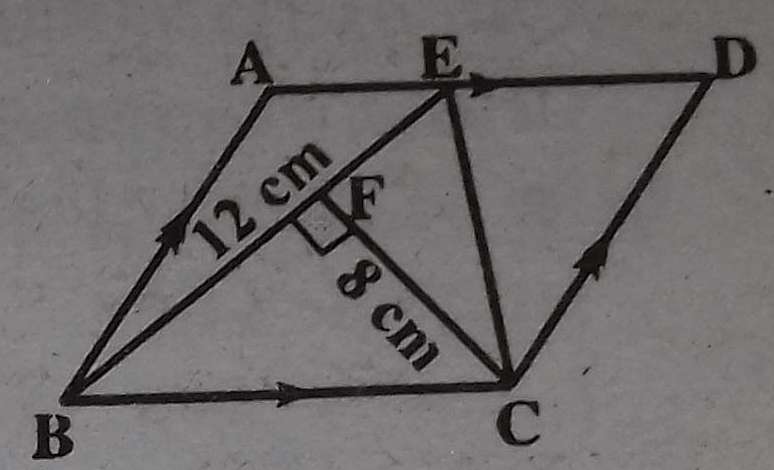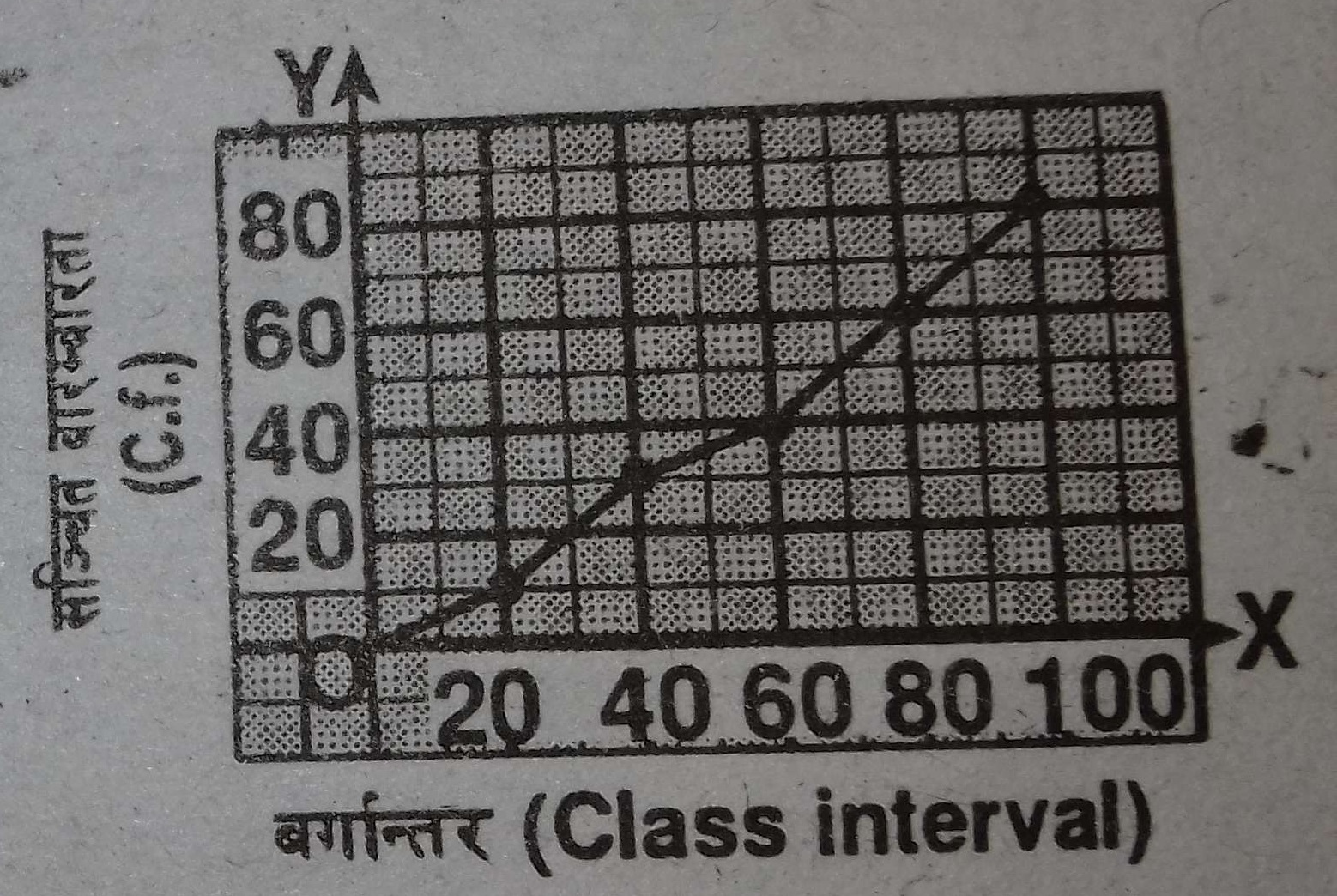Students and Teachers Forum
Area of parallelogram QRUT = b x h = 12 x 4 = 48 cm2 Now, Area of PQRS = Area of QRUT [Area of parallelogram standing on same base between same parallel lines are equal ] Hence, Area of PQRS = 48 .....
19.Solution In triangle ABC, 67o + 43 o+ <BAC = 180o or, <BAC = 180o - 110o= 70o. Now, <BAC = <BDC [ angle on same arch BC are equal] Hence, <BDC = 70o is .....
Construction: E and C are joined. <AEC = 90o [Angle subtended by the diameter in circumference = 90o] <DEC = <DBC = 25o Now, <AED = <AEC + <DEC = 90 + 25 = 115o Hence, <AED = .....
Let's take an example.
If 50% of the total number of students in the class are male, that means that 50 out of every 100 students are male. If there are 500 students, then 250 of them are .....
- If the effort is made bringing with the effective plans and policies for the effective utilization of available natural resources, the industrial revolution in Nepal is possible. - The industrial revolution should be started with the .....
Industrial Revolution, in modern history, is the process of change from an agrarian and handicraft economy to one dominated by industry and machine manufacturing. This process began in Britain in the 18th.century and from there spread to other .....
When sulphuric acid is used in preparation of Carbon dioxide, calcium sulfate is formed, and it has very limited solubility itself. As a result, unless westart with very finely divided calcium carbonate, and agitate the mixture, it will tend .....
- The growth of the manufacturing sectors - The strong desire of people to work in the industrial sectors - The natural resources available in Britain caused the rise of the industrial revolution. - The technological progress led to the .....
The Industrial Revolution began in Europe in about 1750 AD. The Industrial Revolution was, fundamentally a technological revolution. The Industrial Revolution was a big change in the way people worked and goods produced. It began around 1775 in .....
The achievements made in administrative sectors are as follows: - Muluki Ain was published in 1910 BS. - Muluki Khana to collect revenue and many other government offices were established. - Padma Shumsher introduced the first .....
1. Answer: Marsilea belongs to the division Pteridophyta. Its leaves look like a feather. Mucor belongs to the division Thallophyta. Mucor lacks chlorophyll. Liverworts belong to the division Bryophyta. It can survive both in water and on .....
The industrial revolution resulted in a great deal of negative (and positive) outcomes. Some negative outcomes .....
Here, Number of guests = 320 Space in ground for each = 3 m2 Hence, Total area covered in ground = 320 x 3 = 960 m2 Again, Total Volume of the conical cone = Air required per guests x Total number of guests = 320 x 10 = 3200 .....
Here, Area of triangle AFE = 2 x Area of triangle ABF [B being the mid point of AE] Also, Area of parallelogram ABCD = 2 x Area of ABF [Area of Parallelogram standing on a same base and between same parallel lines as of a triangle is double the .....
Let the height of the pyramid be 'p'. In the right angled triangle of the pyramid, hypotaneous(h) = 13 cm. Base(b) = 10/2 = 5 cm. Now, We know, h2 = p2 + b2 or, p = √(h2 - b2) = √(132 - 52 ) = 12 .....
In circle with arc ADCB, <ABF = <ADC = 92o [Exterior angle of a cyclic quadrilateral is equal to opposite interior angle] Again, In circle with arc AEBF, <AEF = ABF = 92o [Angle subtended by same arc AF in .....
<EOF = 2 x <EDF [Angle in center is double the angle at circumference subtended by same arc] = 2 x 75o Therefore, <EOF = 150o Now, <OEF = <OFA = 90o [Line joining center and the point of tangent is perpendicular to the .....
Here, Radius of one ring(r) = 6/2 = 3 feet. Height (h) of one ring(h) = 1.5 feet Hence, Volume of water that can be stored on one ring = πr2h = 22/7 x (32)x (1.5) = 42.4286 (ft)3 Now, Volume of water that can be stored on .....
17) We know, Area of square PQRS =QR2 =42 = 16 cm2 Hence, Area of square PQRS = 16 cm2. We know, Area of triangle QRT = 1/2 Area of square PQRS [The area of triangle is half the area of square standing on the same base between same parallel .....
We know, Area of square PQRS = 2 x Area of Triangle PST [Area of a square is double the area of triangle standing on a same base and between same parallel lines] Therefore, Area of square = 2 x 40 = 80 cm2 But, We know, Area of .....
Now, area of parallelogram ACDE = 2 area of ∆ABC .....
18) In circle with arc ADCB, <ABF = <ADC = 92o [Exterior angle of a cyclic quadrilateral is equal to opposite interior angle] Again, In circle with arc AEBF, <AEF = ABF = 92o [Angle subtended by same arc AF .....
17) In triangle SDC, BC2 = BD2 + DC2 [Using pythagoras theorem] or, 52 = BD2 + 32 or, BD = √(52 - 32) Therefore, BD = 4 cm. Now, Area of triangle BDC = 1/2 BD x DC = 1/2 x 3 x 4 = 6 cm2 Now, Area of triangle ABC .....
Statement Reasons 1) Area of triangle PMN = Area of triangle QMN Triangle standing on same base between same parallel lines have equal areas 2) Area of triangle MNS = Area of triangle MNR Triangle standing on same .....
17) Here, Diagonal of the squre(AC) [d] = 5√2 cm. We know, Area of square = d2/2 = (5√2)2 = 50 cm2 Now, Area of parallelogram DEFC = Area of square ABCD [Parallelogram standing on same base between same parallel lines .....
Here, Let P(-1, 3) = (x1, y1) and Q(4, 3) = (x2, y2)are two points. We know, Slope(m1) of PQ = (y2 - y1)/(x2 - x1) = (3 - 3)/(4 - (-1)) = 0 Hence, slope(m1) of PQ = 0 Now, RM is perpendicular to PQ. Let the slope of RM = .....
We know, Area of square MNOP = 1/2 x d2 = 1/ 2 x [6cm]2 = 18cm2. Area of ∆POQ = 1/2 of area of MNOP [ //gm and triangle on same base and between same //s] .....
Again, ∡BOD = 2∡BCD [ Inscribed angle is half of centre angle] So, ∡BOD = 2 x 60∘ = .....
Here, Area of rectangle ABCE= length x base = 10cm x 8cm = 80cm2. We know, Area of ∆AED = 1/2 x Area of rectangle ABCE .....
Here, 3RB = 2AP = QS = 6cm or, 3RB = 6cm ==> RB = 6cm / 3 = 2cm And, 2AP = 6cm ==> AP = 6cm/ 2 = 3cm Now, Area of qd. PQRS = 1/2 x QS [ AP + RB] .....
18) <COB = <OCA + <CDB = 30o + 90o Therefore, <COB = 120o Now, <CAB = 1/2 <COB [Angle subtended on center is double the angle at circumference subtended by same arc] = 1/2 x120 = 60o Hence, <CAB = .....
Here, Area of ∆WXY = Area of ∆ZXY [ Area of ∆s on same base and between same //s are equals] or, ∆WXO + ∆ XOY = ∆ZOY + ∆ OXY [ whole part .....
Here, Area of //gm ABCD = base x height = 5cm x 8cm = 40cm2. Again, area of triangle DEC = 1/2 of Area of //gm ABCD .....
Here, Area of parallelogram ABCD = DC x BE = 10 x 12 = 120 cm2 We know, Area of triangle BFC = 1/2 Area of parallelogram ABCD [Area of Triangle is half the area of parallelogram standing on the same base and between same parallel lines .....
<DAB = <DCB [Opposite angles of a parallelogram are eqaul] or, 100o = <DCE + <ECB or, 100 = 10 + <ECB Hence, <ECB = 90o . Now, In triangle ECB, Because <ECB = 90o, Area of triangle ECB = 1/2 x EC x BC = 1/2 .....
Statement Reason 1) NABM is a parallelogram MB ||NA and , MN || AB 2) MNDC is a parallelogram DN || BC and DC || MN 3) Area of triangle AXB = 1/2 Area of parallelogram NABM Traingle .....
Construction :M and B ar joined. Statement Reasons 1) Area of Triangle MAB = 1/2 Area of parallelogram ABCD Triangle standing on the same base and between same parallel lines of a parallelogram in half the area of .....
The first quartile (Q1) is defined as the middle number between the smallest number and the median of the data set. The second quartile (Q2) is the median of the data. The third quartile (Q3) is the middle value between .....
Statement Reason 1) In triangle ABC, DE || BC Line joining mid points of two sides of a triangle is parallel to third side 2) In triangle ABC, EF ||AB Line joining mid points of two sides of a triangle is .....
Here, Area of △ ABC = 1/ 2 Base x Height = 1/ 2 x 6cm x 8cm = 24cm2 Area of △ AMC = 1/ 2 △ ABC [ median CM bisect △ ABC] .....
Here, Radius(r) = 18/2 = 9 cm. height of the cylinder(h) = 25 cm. Now, Volume of the total solid = Volume of the cylinder + Volume of the sphere = πr2h + 4/3 πr3 = 22/7 (92 x 15 + 4/3 x 93) = 22/7 x (1215 + .....
We know, Area of triangle EBC = 1/2 BE x FC = 1/2 x 12 x 8 = 48 cm2. Now, Area of parallelogram ABCD = 2 x Area of triangle BEC [Area of parallelogram standing in same base and between same parallel line of a triangle is .....
Here, Total Frequency(N) = 80 We know, Median lies in the class with N/2 Here, N/2 = 80/2 = 40 Now, Corresponding class with CF = 40 is: (40 - 60) or (60 - 80) [Note that, because 40 lies in the boundry line, you can write either (40 - 60) .....
18) In circle with arc ADCB, <ABF = <ADC = 92o [Exterior angle of a cyclic quadrilateral is equal to opposite interior angle] Again, In circle with arc AEBF, <AEF = ABF = 92o [Angle subtended by same arc AF .....
We know, Area of quadrilateral = 1/2 x d x(d1 + d2) [Where, d is the diagonal of the quadrilteral and d1 and d2 are the perpendicular from veritces two vertices to the diagonal d.] Here, d = BD = 8 cm d1 = NA = 6 cm d2 = CM = 3 .....
Now, <ACB = 90o [Angle subtended by diameter in circumference is 90o] Alos, <ACB = 60o + <DBC [Sum of interior angle of a triangle is equal to opposite exterior angle] or, 90 = 60 + <CAD Therefore, <CAD = .....
Here, OT is perpendicular to TP. [ Radius is perpendicular to Tangent] So, triangle OTP is right angle triangle. Using pythagoras theorem, or, OP2 = OT2 + TP2 52 = 32 + TP2 or, TP2 = 16 or, PT = .....
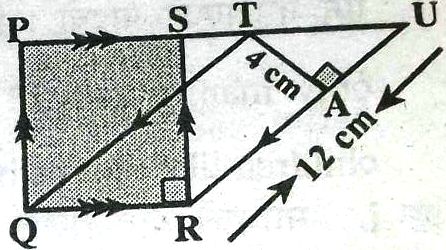
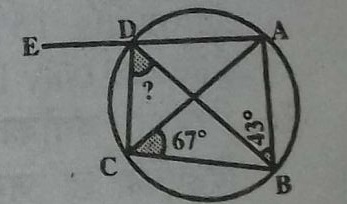
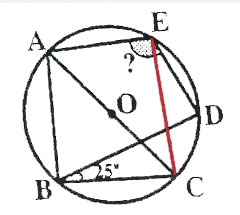
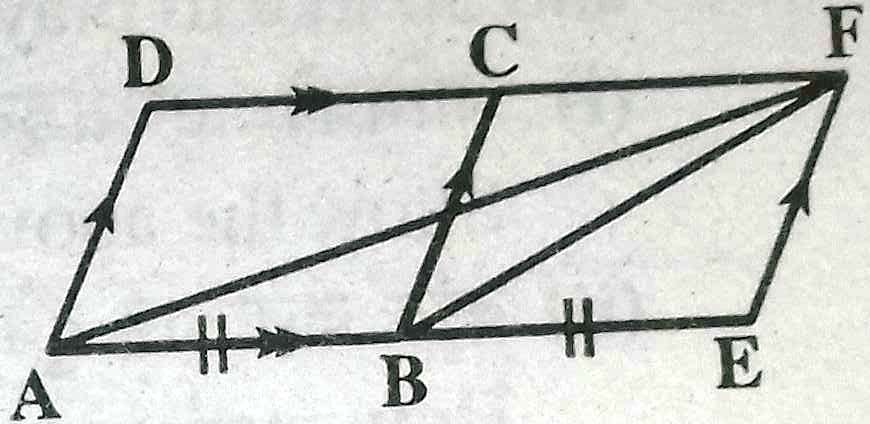
.jpg) question no. 17 18 and 19
question no. 17 18 and 19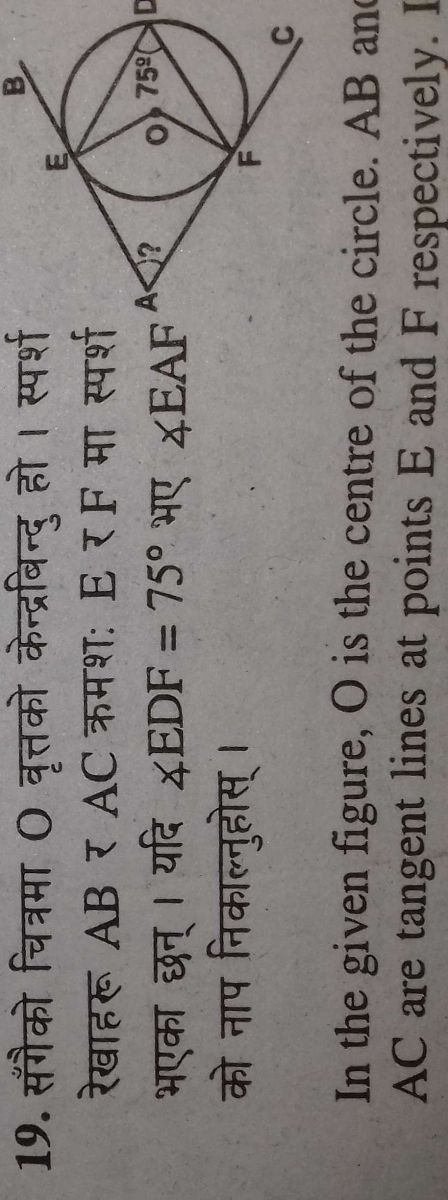

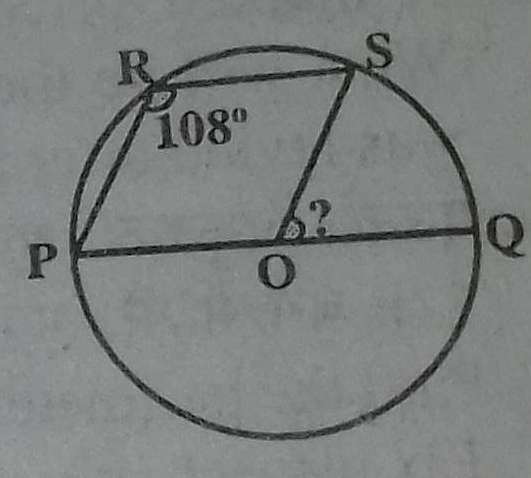
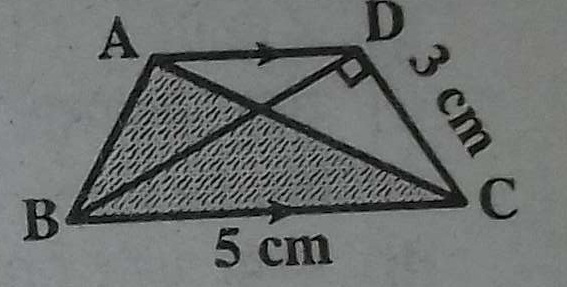
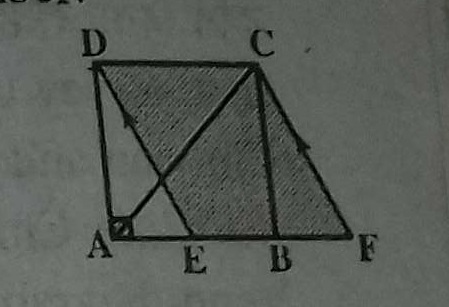
.jpg)
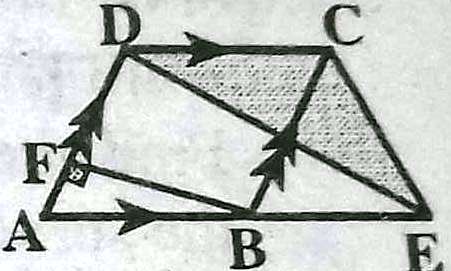
.jpg)
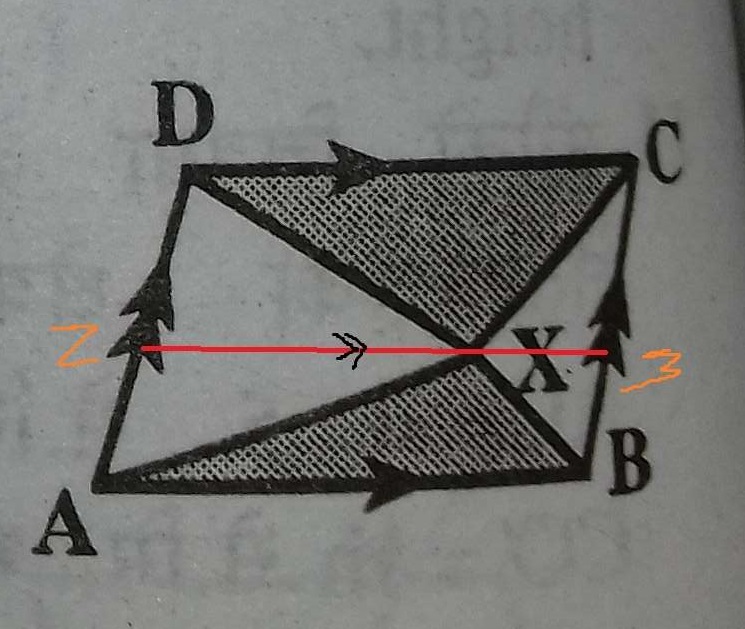
.jpg)
